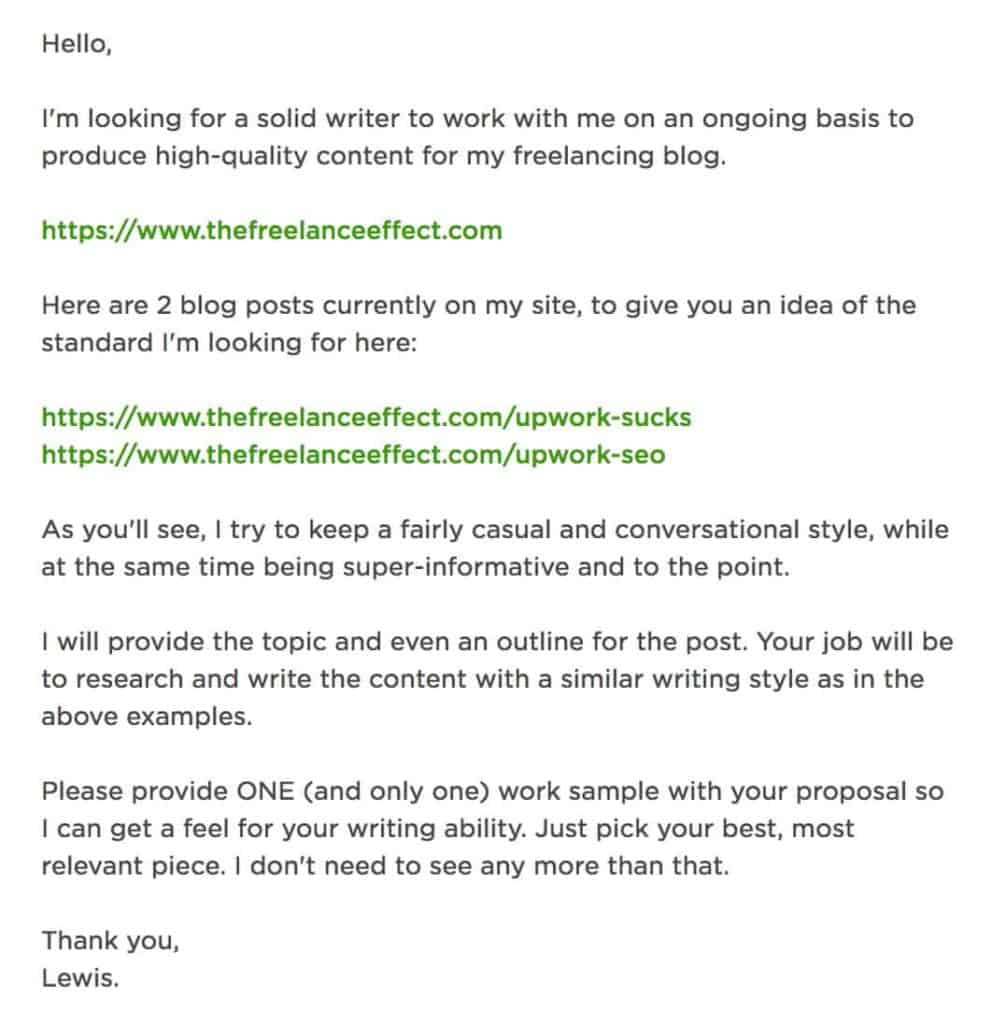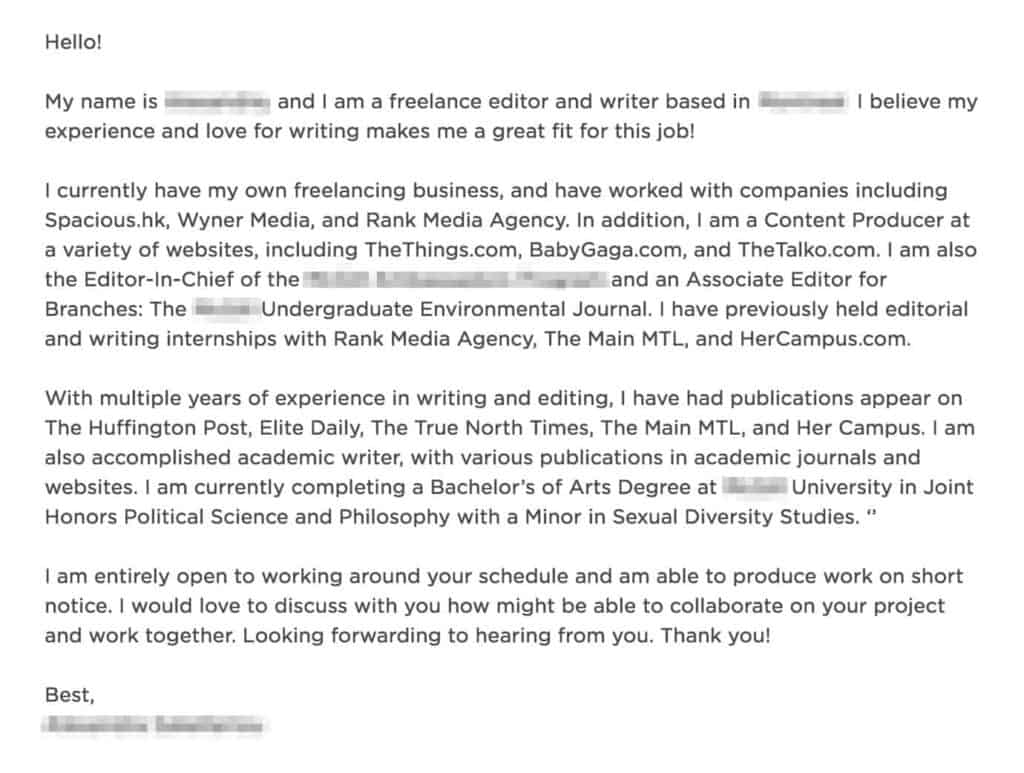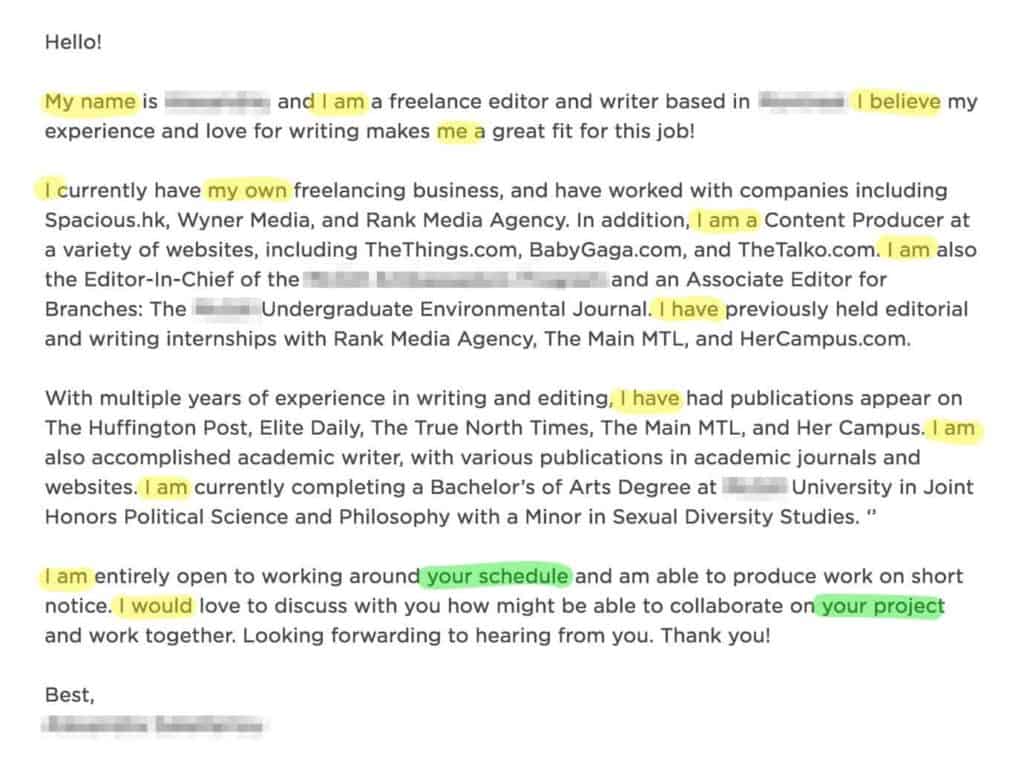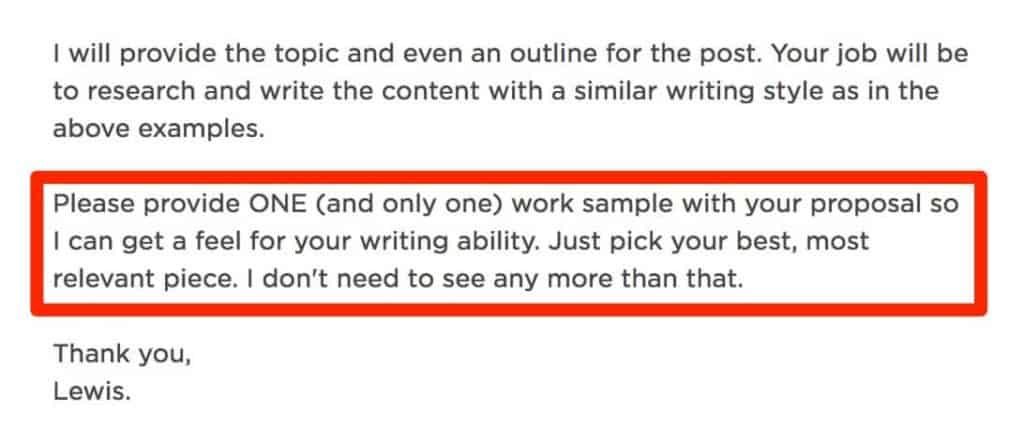Ahh… Upwork proposals.
As a long-time Upwork client, I’ve personally read well over 1,000 proposals and hired my fair share of freelancers along the way.
If there’s one thing I can say without a doubt, it’s that the majority of proposals I’ve received over the years have been… well… awful.
The truth is, most freelancers are completely oblivious to what really makes a great Upwork proposals (even if they think they know).
So here’s the deal…
Today, I’m not just going to tell you what makes a winning Upwork proposal, I’m going to show you.
Making The Cut
I recently posted the below job ad on Upwork (twice), where I was looking to hire a content writer.

Within 24 hours, I’d already managed to attract a couple dozen applicants.
As usual, though, I ended up deleting 98% of the responses I received. (Out of 31 responses, I was left with 2 reasonably good candidates.)
Like I said…
…I’ve gone through this elimination process countless times already, and this kind of result isn’t too far from the norm.
If you’ve ever found yourself applying to endless jobs only to never hear back, it’s because you’re just not making the cut.
The good news?
It’s easily fixable once you learn and implement what I’m about to teach you. Today, I’ve picked out one cover letter I’d like to share with you.
Obviously, my goal isn’t to “out” anybody here, it’s to highlight common mistakes in the hope that I can help you better your proposals and land more clients.
Note: When I say “proposal”, in most cases, I’m actually talking about the cover letter in particular, which is the written part of an Upwork proposal.
The Cover Letter
Below is the cover letter we’ll be analyzing, and this is one I received only a few days ago in response to my job ad.
I’ve blurred out some personal information for anonymity, but have a quick read over it. Please. 🙂

I chose this one for the case study because if you read it, you’ll probably struggle to find anything inherently “wrong” here.
(In fact, it’s a lot better than most proposals I receive through Upwork.)
But, while I will admit this isn’t a terrible cover letter, there are still a few fundamental flaws I’d like to address.
Pay attention, because I bet your bottom teeth you’re doing at least one of these yourself.
The Bad Stuff
#1: THE SALUTATION
Before we even get into the meat of this cover letter, there’s already a slip up on the very first line.
If you look at my job advert again, you’ll notice I actually included my name at the very end.

Obviously, this freelancer didn’t bother to address me by name, despite the fact I gave it to them on a silver platter.
Maybe they didn’t read the entire job ad, or maybe they just didn’t think it was important to include it. Either way, these are not traits I would personally be looking for in a freelancer.
Lewis’s Pro TipMany clients – including myself – purposely include a name to quickly eliminate ~60% of applicants who miss it. It’s just another filter, so don’t get caught by it.
#2: THE ANGLE
This is the one most freelancers get caught up in – and likely the one you missed after reading the cover letter.
It’s not what they said, it’s HOW they said it. The entire letter is focused on the freelancer, not the client.
In fact, just look at how many “me” statements there are (yellow) compared to statements that are focused on me (green):

Look, I get it. It makes complete sense to mention your achievements, your experience, and your talents. There’s nothing wrong with that.
But unless you can directly relate those things back to the client and explain exactly how they will benefit, none of it matters. It’s just waffle.
Lewis’s Pro TipTry turning a “me” statement into a “you” statement wherever possible. And if you absolutely have to talk about yourself, be clear about why the client should even care.
#3: THE LENGTH
I always get asked about the “correct” length for a cover letter, and honestly, it’s hard to say exactly what that is.
What I can say is, the goal should be to include only the essential elements in as few words as possible. (It’s obvious, but you’d be surprised.)
From my experience, the sweet spot tends to be somewhere around 120-150 words. Considering this cover letter stands at 226 words, it’s already a bit too long in my opinion.
Remember, clients are busy people. The last thing they want to see is a wall of text. Keep it short, fluff-free and punchy.
Lewis’s Pro TipPsst.. I share my exact cover letter structure with email subscribers. Just click this box if you’re down.
#4: THE SAMPLE
This is another “hidden” filter I plant inside my job ads.
Some freelancers are very quick to just point you to their portfolio and have you wade through different samples until you find a relevant piece. (Please, please, pleeeeease don’t do that.)
Others will do one slightly better and attach half a dozen relevant pieces to the cover letter itself. But again, that’s hardly respecting the clients time.
That’s why, in my job ads, I make sure to slot this little gem in somewhere:

Even with that so bluntly thrown in, roughly HALF of applicants fail to include a single sample piece.
The proposal (or cover letter) above was no exception. No links. No attachments. Not even a portfolio on Upwork. Nothing.
The Good Stuff
#1: CREDIBILITY
If there’s one thing this cover letter is full to brim with, it’s credibility.
This particular freelancer is involved at high-level with several recognized online publications. And that says a LOT in terms of writing ability.
Not only that, but I can actually verify whether these claims are true, just by going to each website and looking for the name. (Some form of verification is crucial whenever you’re trying to establish credibility.)
Of course, the freelancer has gone a little overboard in this case, but the right ingredients are definitely buried in there. No doubt about that.
Lewis’s Pro TipIf you’re looking for other ways to establish credibility, I wrote a killer post on something I call “The Mind Map Method“.
#2: SPELLING & GRAMMAR
What can I say… the spelling and grammar is flawless.
As someone who’s hired more writers than anything else on Upwork, it’s clearly important for me to see stellar writing ability within the cover letter itself.
Even if you’re not a writer, it still doesn’t hurt to run your cover letter through some free tools before you send it off. (Bad spelling and grammar is still a low quality indicator.)
Conclusion
Your proposal (and your cover letter in particular) is easily one of the biggest contributing factors when it comes to winning contracts.
Fortunately, as long as you follow the principles I’ve outlined in this case study, you’ll be able to take your own cover letters to the next level.
In fact, get yourself over to Upwork right now. Fire off some proposals while this stuff is still fresh in your head. Never know, you might surprise yourself.
Thank you so much!!!!!!
You are very welcome.
This is very helpful Lewis. Thank you for sharing!
My pleasure. Thanks for dropping a comment. 🙂
What a breath of fresh air it has been to read your article and to find your website. After toiling through umpteen BS pages on Google to find some good solid advice, I landed here.
Truly, I am so stoked that I did! I like your logic, real-time ACTUAL experience, and frankness. Following and looking forward to more of your content.
Thank You!
Forgive me, that meant to read…
Thank You Lewis!
Thank you for saving me today. Off to Upwork right away to get it done.
Awesome !!
Thank you Lewis. This is very helpful. I have a question though, i am an university student and i want to use my translation skills there. But i believe most of the clients choose translators that are experienced. Shall i give up?
Hey Lewis! I was looking for an example of an Upwork cover letter for inspiration and found your blog. The example looked ideal, but after you’ve broken down each part, I realized that it needs tweaking. Perhaps looking at the perspective of the client would help. If I were the client, I too would be at a loss on how the candidate can help me with my business.
Hi,
Quick question. Your tips are great for a newbie like myself. I don’t have a “company”. I am an accountant and take private clients but wouldn’t be able to attach anything to the cover letter. Would I just say I can provide references or how would you handle it?
Thanks so much,
dsgrieco
Thanks Lewis. Extremely helpful.